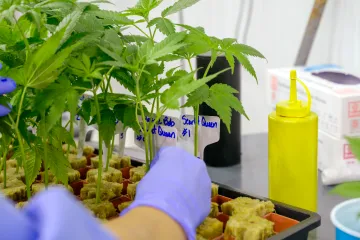Pain and Addiction: Building a Comprehensive Response

Mohab Ibrahim and Todd Vanderah
Photo: Kris Hanning
Experts at the University of Arizona Health Sciences Comprehensive Center for Pain & Addiction are tackling the interconnected issues of substance misuse, chronic pain and addiction.
Approximately 100 million people in the U.S. are affected by chronic and acute pain, which can negatively impact peoples’ lives in significant ways and increase rates of morbidity, mortality and disability. The opioids traditionally used to treat chronic pain, however, have been implicate-ed in the growing public health crisis known as the opioid epidemic.
In 2017, the U.S. Department of Health and Human Services declared a public health emergency to address the opioid epidemic, which is responsible for the deaths of more than 47,000 people a year in the U.S.
Both issues — chronic pain and the opioid epidemic — are complex, and finding a solution will require a collaborative mindset and a multifaceted approach. That’s where the Comprehensive Center for Pain & Addiction comes in.
“Everybody seems to know somebody with an addiction problem,” says Todd Vanderah, Ph.D., director of the Comprehensive Center for Pain & Addiction and Regents Professor and head of the College of Medicine – Tucson’s Department of Pharmacology. “We don’t do a great job of treating chronic pain, since physicians and insurance plans have been limited to the idea of simply prescribing a medication like opiates.

Cannabis sativa contains about 540 chemical substances known as cannabinoids, several of which are being studied as potential options for non-opioid pain relief.
Photo: Kris Hanning
“When you look at how many people have troubles with pain and addiction, it’s interesting that nobody has organized a center that focuses on all the aspects — health care, education, re-search, clinical trials, legislation, technology — to improve outcomes. That’s our goal: We’re going to look at all of it as a cohesive group.”
Many of the center’s scientists, Vanderah included, are researching alternatives to opioids and testing those novel molecular compounds in preclinical studies. Other members, including Mohab Ibrahim, MD, Ph.D., the center’s medical director and a pain management physician, specialize in studying and treating chronic pain.
“When someone comes to us with a chronic pain condition, we do a comprehensive medical exam and history. We try to find out everything that’s medically related to the condition, and based on that, we’ll come up with a complete plan,” says Ibrahim, a professor of anesthesiology in the College of Medicine – Tucson and director of Banner – University Medical Center’s Chronic Pain Clinic. “It’s not always medications that help. Sometimes, it’s some-thing as simple as lifestyle modification.”
The Comprehensive Center for Pain & Addiction offers researchers an opportunity to build on preclinical studies in medicinal chemistry, drug formulation and pharmacokinetics with potential clinical trials of Food and Drug Administration-approved investigational drugs.
“It would be like a dream to go from the chemistry of actually making new compounds all the way through to patient clinical trials and having a novel medication or therapy accepted by the FDA for use worldwide,” says Vanderah, who also is a member of the university’s BIO5 Institute.
“The only way to advance and move forward is to propose new ideas, explore them and see if they can provide any benefits for the patients,” Ibrahim adds. “One of the ways to do that is through research, and that’s where the center becomes the perfect bridge between clinical medicine and research medicine. It’s where pain physicians, pharmacologists, chemists, pharmacists, neuroscientists and biomedical engineers can come together and share ideas.”
In addition to drug development, key parts of the center’s mission include community outreach, education, legislation and technology development.
“I think many physicians don’t know enough about opiates and addiction, but in addition to educating our clinicians, we need to get the information to the public and into the schools,” Vanderah says.
“I think the biggest impact the Comprehensive Center for Pain & Addiction will have is on our community here, in the state of Arizona,” Vanderah says. “We can help the community with their chronic pain. We can help with understanding one’s addiction, and we can get education out to everybody to better understand how these things can influence the health and well-being of patients, their families and friends.”
